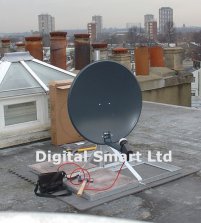Satellite dish installation options

A satellite dish must have a clear line of sight to the satellite. The largest mistake an inexperienced or careless installer will make is locating a dish where trees will partially block the satellite signal, resulting in a lower then normal signal level. ANY signal blockage is unacceptable. Even if you have a clear picture, you can have signal blockage. A satellite dish with a clear line of sight will deliver a signal average of at least 75-80.
Image 1 shows a satellite system which will lose reception when the tree in front of the dish grows leaves. The distant evergreens will not be an issue for several years. Here the small tree was removed.
Satellite broadcast channels are called transponders. Each transponder contains up to 20 TV channels. The minimum signal level for a transponder to provide a clear picture is about 40. Atmospheric conditions such as rain, snow and dust affect the strength of the signal. During a heavy rain storm (rain fade), you may loose some or all of your signal. If your system has an average signal level of 60, you will experience more outages then someone who has an average signal strength of 75. The satellite industry considers 70 as the minimum signal level for all transponders. Some transponders are not used and will have a 0 signal level. Others are not meant to be used in your geographical area and may have signal levels far below normal.
Do not accept an average signal level of 70. 70 is the minimum considered as acceptable, but only a few should be that low. Most signal levels will be around 75 or higher.
Image 2 shows an installation where the installer did not inform the customer that trees would be a problem. This picture was taken 4 months after the original installation. The customer was told that their signal levels of 50-60 were normal. Here the dish was relocated, at the expense of the customer.
Image 3 shows an installation were the installer was required to install the dish at the highest peak to avoid any future tree problems. This installation is not a basic or standard installation. When the installer is required to walk on a roof to access the dish location, the installer will usually charge a service fee for this type of work. Not all installers will even offer to provide this type of installation. If your installer refuses to provide this type of additional charge installation, even in safe conditions, you are usually better off seeking a different installation company, which does offer this form of custom installation.
A dish should not be installed if any tree growth will block signal within 1 year. If your installer cannot guarantee that you will have a clear line of site for a period of time you find acceptable, then you should seek another location, installer or perhaps even consider another system.
A common practice to avoid tree problems is to mount the dish on a ground post. Do not use a wood post, it may twist over time. The installer should carry a steel post and concrete. The installer will charge extra for this custom work, but it may be your only option. If your installer does not offer a steel ground post option, you should seek an installer that will.
Image 4 illustrates the different satellite locations used by DirecTV and Dish Network. In this case the customer was not sold a DirecTV system because the trees on the left would block the signal from DirecTV. This customer will never have a problem receiving Dish Network.
DirecTV and Dish Network use different satellites for their core programming. For satellite Internet service there is also more then one choice. Often you will find that one system will work better for you due to a better line-of sight. Your installer may not be able to discuss your other options because of their obligations to the client that sent them to you. But, you can ask for their advice. Most good installers will help you. If not, you can contact DBS Install for a site survey service call.

|
Winegard MT-4000 RV Ladder Mount for G2+/Pathway X1 Satellite Antennas Automotive Parts and Accessories (Winegard)
|
Related posts:

 How to make squash How to remote control desktop using lan tricks Tricks for keeping marks off your nose when wearing sunglasses Quickbooks help how to enter tips…
How to make squash How to remote control desktop using lan tricks Tricks for keeping marks off your nose when wearing sunglasses Quickbooks help how to enter tips… As both J.D. Power and Associates and Consumer Reports have noted, satellite enjoys a superior customer service rating among its multichannel competitors. Sustaining…
As both J.D. Power and Associates and Consumer Reports have noted, satellite enjoys a superior customer service rating among its multichannel competitors. Sustaining… What does tin stand for Tips on how to breed better dragons in dragonvale Linus tech tips how to build a pc what does negative mean what is capital murders mean…
What does tin stand for Tips on how to breed better dragons in dragonvale Linus tech tips how to build a pc what does negative mean what is capital murders mean… Simply activate the receiver through an existing DISH account or subscribe to a new Pay-As-You-Go programming package. Pathway X2 can point to either Western or…
Simply activate the receiver through an existing DISH account or subscribe to a new Pay-As-You-Go programming package. Pathway X2 can point to either Western or… A Dish Network digital video recorder (DVR) is controlled by a specialized remote that is provided with it. The Dish Network remote uses a code that allows it to…
A Dish Network digital video recorder (DVR) is controlled by a specialized remote that is provided with it. The Dish Network remote uses a code that allows it to…